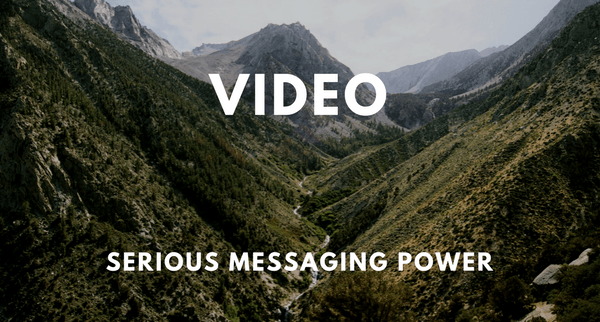
Reading Time: 3 minutes
Ever get misty-eyed at a movie? Can you remember a commercial that’s over 10 years old? Chances are, you can say “yes.”
Why? The format. How the information was delivered resulted in your recollection.
 A static image can convey complex information more easily and in less time than text alone. Video compounds this, firing 30 pictures at you every second to actively process and absorb. “The brain processes images 60,000 times faster than it does text.” (B2C)
A static image can convey complex information more easily and in less time than text alone. Video compounds this, firing 30 pictures at you every second to actively process and absorb. “The brain processes images 60,000 times faster than it does text.” (B2C)
Serious messaging power.
The power is harnessed by more than just frequency. It resides in the fusion of music, graphics, text, and voice, that together amplify emotional response and recall. “When customers remember your video marketing content, they also remember your brand, which translates to more sales and leads for you.” (Forbes 2017)
Historically, there was a financial barrier to producing video. For TV, both the production and airtime were big bucks. Industrial videos, made for corporate training, sales or B2B, were also expensive. And, their limited impressions drove up cost-per-view.
 Enter the 21st century. There are now a plethora of online delivery platforms. Video can be consumed on any screen in almost any format. Major reach. Video has proven its worth as 4X as many customers would rather watch a video about a product than read about it. (Hubspot) Even when selling offline, almost 50% of internet users first look for product or service videos online.
Enter the 21st century. There are now a plethora of online delivery platforms. Video can be consumed on any screen in almost any format. Major reach. Video has proven its worth as 4X as many customers would rather watch a video about a product than read about it. (Hubspot) Even when selling offline, almost 50% of internet users first look for product or service videos online.
Side note
Video’s power doesn’t diminish other mediums. Some of the most effective content marketing is when components integrate. A riveting image grounded by a clever tweet or a gripping video teaser can push readers to a timely blog post. Pure harmony.]
Once set on making a video there are multiple elements to weigh.
Know your audience
The what, how, and where they consume media will help shape the length and style of your video. If you’re drawing a blank, learn how to identify and communicate with your targets. The requirements for a 6-second pre-roll vs a 2-minute how-to will drastically alter your budget and schedule.
Content first
Before hiring a production company, remember that a successful video is more than slick graphics, dramatic lighting, and booming bass. The purpose of your video is to drive engagement, a click or a share. The intent can be as simple as awareness or as focused as lead generation.
Whether you or an agency is crafting your script, start with why. Why are viewers going to care?
Facts and figures are often used in advertising to differentiate. However, they can be uninspiring and hard to remember without the foundation of a story to makes them relevant. Stories inherently deliver emotional ideas that make visceral associations for the viewer.
“Stories drive action through simulation (what to do) and inspiration (the motivation to do it)”, said Chip and Dan Heath in Made to Stick. Stories sell. People can understand them, relate to them and remember them.
Storytelling doesn’t mean complex. In fact, a video needs to be so simple that there is no chance viewers will misunderstand what they are being asked to do.
Case study
A challenge UCHealth faced was getting adults to seek preventive care and early detection screenings. Our solution was inspired by something about as meaningful as life can get, our children and grandchildren. After reading my son a bedtime story, I developed the concept for “What’s Love?” The 30-second spot features children speaking directly to the adults in their lives, yet flips the power dynamic by issuing a stern yet loving reminder of all the experiences they wish to share. At its core, the message is “take care of yourself, so you can be there.” Heartfelt and relatable. It concludes with a clear call-to-action.
Medium matters. The video was geo-targeted to segments on YouTube and other regional networks. Prior to this, video had not been used to influence behavior. As part of an integrated campaign, we saw a 22% increase in clinic visits.
Format by intent
 YouTube, synonymous with online video, is served in many flavors. Organic is what users upload to their account without having yet engaged in paid promotion. These videos can be used on a site, blog, email campaign, or social. It’s often the choice for brand messaging, how-tos, product updates, and customer stories. Use your SEO keywords and phrases when filling out the video’s description and keyword fields.
YouTube, synonymous with online video, is served in many flavors. Organic is what users upload to their account without having yet engaged in paid promotion. These videos can be used on a site, blog, email campaign, or social. It’s often the choice for brand messaging, how-tos, product updates, and customer stories. Use your SEO keywords and phrases when filling out the video’s description and keyword fields.
On the advertising side you’ve got choices to make, like skippable, non-skippable and bumper ads. Which you select is dependent on the goal (e.g. awareness v lead generation). And, there is an assortment of other distribution networks, depending on your reach and budget.
A picture’s worth a thousand words. An idiom or a fact? According to Forrester Research’s Dr. James McQuivey, “a minute of video is worth 1.8 million words.” The power of video is evident. When planning your next campaign, consider video as part of the mix.
